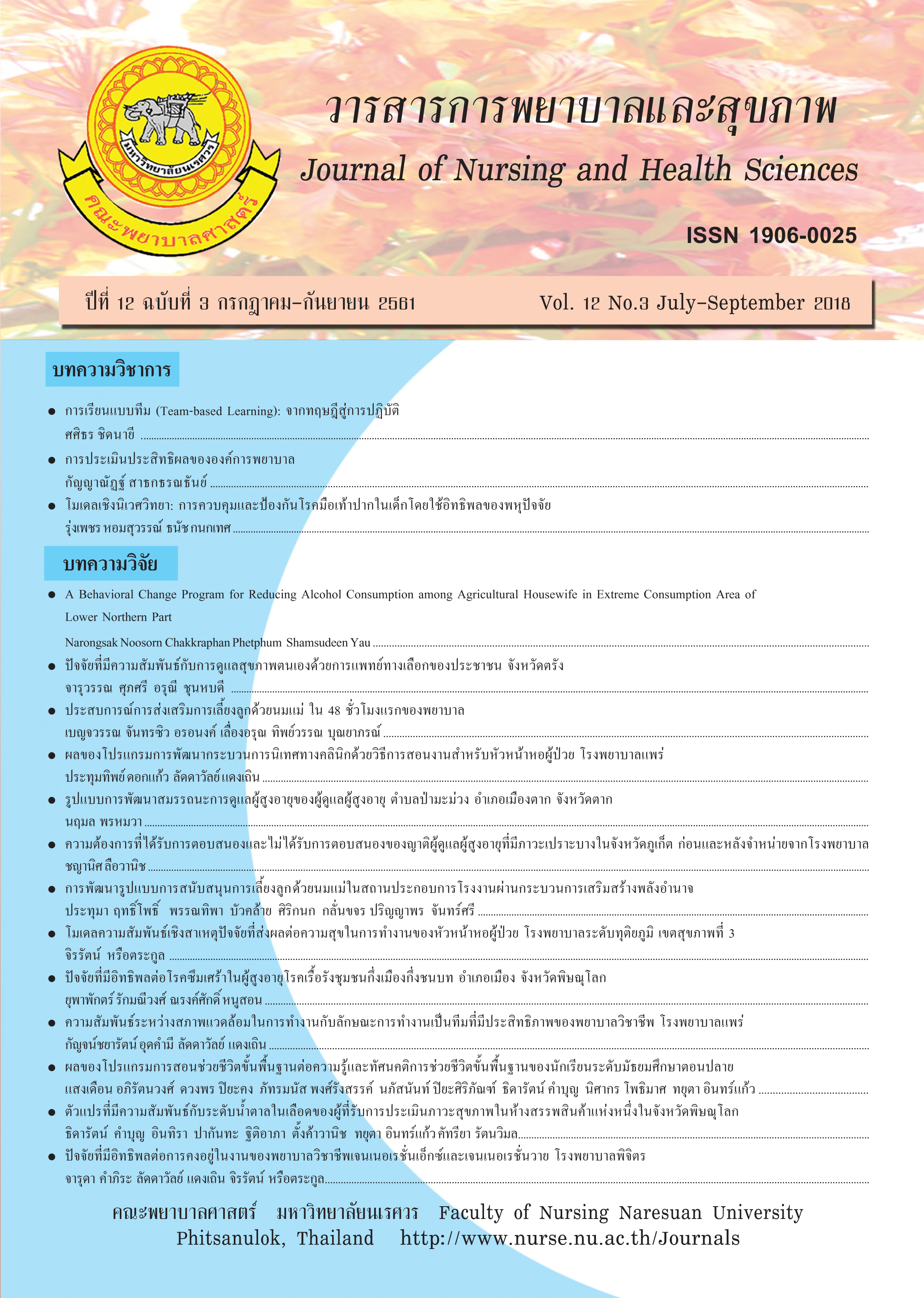การพัฒนารูปแบบการสนับสนุนการเลี้ยงลูกด้วยนมแม่ในสถานประกอบการโรงงาน ผ่านกระบวนการเสริมสร้างพลังอำนาจ
Main Article Content
บทคัดย่อ
การเลี้ยงลูกด้วยนมแม่เป็นนโยบายที่ทุกประเทศทั่วโลกให้ความสำคัญ แต่อุปสรรคสำคัญอย่างหนึ่ง ที่ทำให้การเลี้ยงลูกด้วยนมแม่ ในประเทศไทยยังไม่ประสบความสำเร็จ คือ การที่แม่ต้องออกไปทำงาน นอกบ้าน ดังนั้นการวิจัยเชิงปฏิบัติการในครั้งนี้มีวัตถุประสงค์เพื่อพัฒนารูปแบบการสนับสนุนการเลี้ยงลูก ด้วยนมแม่ ในสถานประกอบการโรงงานผ่านกระบวนการเสริมสร้างพลังอำนาจในเขตภาคเหนือตอนล่าง การดำเนินการวิจัยในการเสนอครั้งนี้แบ่งได้เป็น 2 ขั้นตอนของวงจรวิจัยเชิงปฏิบัติการ ได้แก่ 1) ขั้นตอน ของการประเมินสถานการณ์การสนับสนุนการเลี้ยงลูกด้วยนมแม่ในสถานประกอบการโรงงาน ผ่านแบบ สอบถามออนไลน์ กลุ่มตัวอย่างเป็นหัวหน้าฝ่ายพัฒนาบุคคลากรของสถานประกอบการโรงงาน จำนวน 100 แห่ง ที่ผ่านการอนุญาตจากกระทรวงสาธารณสุขแล้ว และ 2) ขั้นตอนการพัฒนารูปแบบ การสนับสนุนการเลี้ยงลูกด้วยนมแม่ในสถานประกอบการโรงงานตอบรับเป็นต้นแบบการสนับสนุน การเลี้ยงลูกด้วยนมแม่ จำนวน 2 แห่งเครื่องมือที่ใช้ในการวิจัยใช้แนวคิดการเสริมสร้างพลังอำนาจของของ คอนเจอร์และคานูโก (Conger & Kanungo, 1988) มี 5 ขั้นตอนของกระบวนการเสริมสร้างพลังอำนาจ สถานประกอบการโรงงานเพื่อสนับสนุนการเลี้ยงลูกด้วยนมแม่ ได้แก่ แบบสอบถามการสนับสนุน การเลี้ยงลูกด้วยนมแม่ในสถานประกอบการโรงงาน และแบบสอบถามเชิงคุณภาพในกระบวนการ พัฒนาการรูปแบบสนับสนุนการเลี้ยงลูกด้วยนมแม่ แบบสอบถามเชิงปริมาณมีค่าความเชื่อมั่นมากกว่า 0.8 วิเคราะห์ข้อมูลเชิงปริมาณโดยสถิติเชิงพรรณนาและวิเคราะห์เชิงเนื้อหาของข้อมูลเชิงคุณภาพ ผลการศึกษาพบว่ารูปแบบการสนับสนุนการเลี้ยงลูกด้วยนมแม่ในสถานประกอบการโรงงานมี 6 องค์ประกอบ ได้แก่ 1) จุดประกายความรับผิดชอบต่อสังคม 2) สะท้อนจุดอ่อนการสนับสนุนเลี้ยงลูก ด้วยนมแม่ 3) บูรณาการนโยบายการเลี้ยงลูกด้วยนมแม่เป็นส่วนหนึ่งในแผนงานสนับสนุนสวัสดิการของ บุคลากร 4) สนับสนุนข้อมูลและแนวทางดำเนินการสนับสนุนการเลี้ยงลูกด้วยนมแม่ในสถานประกอบการ โรงงาน 5) เสริมพลังบทบาทการเลี้ยงลูกด้วยนมแม่เป็นส่วนหนึ่งของหน้าที่ของลูกจ้างและ 6) ติดตามและ สนับสนุนการเป็นต้นแบบสถานประกอบการโรงงานที่ประสบความสำเร็จในการเลี้ยงลูกด้วยนมแม่
Article Details
เอกสารอ้างอิง
พยาบาล.สืบค้นจาก http://www.ns.mahidol.
ac.th/english/th/ns_academic/56/08/research_
tool.html
คณะกรรมการจัดทำแผนของกระทรวงสาธารณสุข.
(2544). แผน 9 ของกระทรวงสาธารณสุขตาม
แผนพัฒนาเศรษฐกิจและสังคมแห่งชาติใน
ช่วงแผนพัฒนาเศรษฐกิจและสังคมแห่งชาติ
(พ.ศ. 2545-2549).นนทบุรี: กระทรวงสาธารณสุข.
นิตยา สินสุกใส, ฉวีวรรณ อยู่สำราญ, และรุจา ภู่ไพบูลย์.
(2557). พฤติกรรมการเลี้ยงลูกด้วยนมแม่ใน
ชุมชนชานเมือง. วารสารสภาการพยาบาล, 29(3),
69-79.
ภัทรพร ชูประพันธ์, วีณา เที่ยงธรรม, และปาหนัน พิชย
ภิญโญ. (2558).ปัจจัยที่มีอิทธิพลต่อการเลี้ยงลูก
ด้วยนมแม่อย่างเดียว 6 เดือน ของแม่ในเขตภาค
กลางตอนล่าง. สืบค้น14 เมษายน 2557, จาก
https://gsbooks.gs.kku.ac.th/57/grc15/files/
mmp73.pdf
มูลนิธิศูนย์นมแม่แห่งประเทศไทย. (ม.ป.ป. ). แผนการ
ส่งเสริมการเลี้ยงลูกด้วยนมแม่. สืบค้น13
เมษายน 2557, จากhttp://www.thaibreastfeeding.
org/ upload/content/file/plan.docx
วิภารัตน์ สุวรรณไวพัฒนะ.(2554).การเสริมสร้างพลัง
อำนาจในสตรีที่ต้องการเลี้ยงลูกด้วยนมแม่.
สืบค้น13 เมษายน 2557, จาก journal. knc.ac.th/
pdf/17_2_2554_5.pdf
สำนักงานคณะกรรมการพัฒนาเศรษฐกิจและสังคม
แห่งชาติ. (2555). แผนพัฒนาเศรษฐกิจและ
สังคมแห่งชาติฉบับที่ 11 (พ.ศ. 2555-2559).
สืบค้น14 เมษายน 2557, จาก http://www. nesdb.
go.th/download/article/article_ 2016032311
2431. pdf
สำนักงานสถิติแห่งชาติ. (2558).สรุปผลที่สำคัญ
การทำงานของสตรีในประเทศไทย พ.ศ. 2557.
กรุงเทพฯ: สำนักงานสถิติแห่งชาติ.
สำนักงานประกันสังคม.(2561). สิทธิประโยชน์กรณี
คลอดบุตรที่ผู้ประกันตนจะได้รับ. สืบค้น 27
เมษายน 2561, จาก https://www.sso.go.th/wpr/
assets/upload/files_storage/sso_th/ eaf9771
afb37b1c24424601c9969f200.pdf
สุสัณหา ยิ้มแย้ม. (2555). การพัฒนาการสนับสนุน
การเลี้ยงบุตรด้วยนมแม่ในสถานประกอบการ
โรงงาน.วารสารสภาการพยาบาล, 27(2), 122-123.
สุสัณหา ยิ้มแย้ม. (2545). รายงานการวิจัยเรื่อง ปัจจัย
ทางด้านสังคมเศรษฐกิจ วัฒนธรรม และนโยบาย
ที่มีต่อการปฏิบัติการให้นมแม่แก่บุตร ในแม่
ที่ทำงานในเขตจังหวัดเชียงใหม่. เชียงใหม่:
คณะพยาบาลศาสตร์.
อรนุช เชาว์ปรีชา,และสุดประนอม สมันตเวคิน.(2557).
ผลของโปรแกรมการสอนและการติดตามทาง
โทรศัพท์ต่อพฤติกรรมการเลี้ยงทารกด้วยนมแม่
และระยะเวลาการเลี้ยงทารกด้วยนมแม่อย่างเดียว.
วารสารพยาบาลศาสตร์ มหาวิทยาลัยสยาม,
15 (28), 37-50.
Brasileiro, A.A., Ambrosano, G.M.B., Marba, S.T.M.,
& Possobon, R.D. (2012). Breastfeeding among
children of women workers. Revista de
SaudePublica, 46(4), 642-648.
Conger, J. A., & Kanungo, R. N. (1988). The
empowerment process: integrating theory
and practice. The Academy of Management
Review, 13(3), 471-482.
Ferreira, G.R., D’Artibale, E.F., & Bercici, L.O. (2013).
Influence of the extension of maternity leave to
six months on the duration of exclusive
breastfeeding. Revista Mineira de Enfermagem,
17(2), 405-411.
Kemmis, S., &McTaggart, R. (1988). The action
research planner. (3rd edition). Geelong:
Deakin University Press.
Rojjanasrirat, W. (2012). Employers’ support for
breastfeeding questionnaire.Retrieved April
27, 2018 from https://www.questionpro.com/a/
q/employers-support-for-breastfeedingquestionnaire-
2891700
Shosha, G. A. (2012). Employment of colaizzi’s strategy
in descriptive phenomenology: a reflection of
a researcher. European Scientific Journal,
8(27), 31-43.
The CDC Guide to Breastfeeding Interventions.
(n.d.). Support in breastfeeding in workplace.
Retrieved April 13, 2017 from https://www.
cdc.gov/breastfeeding/pdf/bf_guide_2.pdf
World Health Organization and United Nations
Children’s Fund. (2003). Global strategy on
infant and young child feeding. Geneva: World
Health Organization.
World Health Organization. (2012). Adolescent Health.
Retrieved 30 June, 2012, from http://www.
who.int/topics/sdolescent_health/en/


